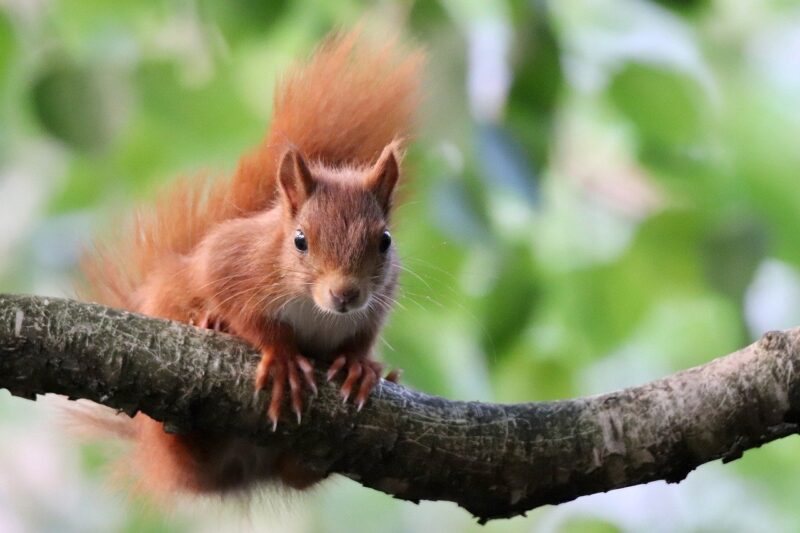The Cleverness of Squirrels: How They Outsmart Predators and Thrive in the Wild
November 13, 2024

Squirrels are often seen as cute, playful creatures, but these furry mammals possess a level of intelligence that allows them to thrive in the wild despite numerous threats. Their cleverness is evident through their behaviors, adaptations, and strategies which help them evade predators and secure food sources. In this article, we will delve into the fascinating world of squirrels, exploring how their intelligence gives them an edge in nature.
1. The Global Squirrel Family
Squirrels belong to the family Sciuridae, which consists of tree squirrels, ground squirrels, chipmunks, marmots, flying squirrels, and other similar animals. Although they are found across the globe, from the Americas to Europe and Asia, their species exhibit varying behaviors and adaptations, influenced by their environment.
One of the most well-known species, the Eastern gray squirrel (Sciurus carolinensis), is commonly found in urban areas and parks, showcasing their ability to adapt to human environments while remaining ever-alert to potential dangers.
2. Adaptations for Survival
Nature continuously tests animals to adapt in order to survive, and squirrels have developed several adaptations to fend off predators and thrive in their environment. Some of these adaptations include:
- Climbing Abilities: Squirrels are outstanding climbers equipped with strong hind legs and sharp claws that enable them to swiftly ascend trees and navigate branches to escape ground-based predators.
- Keen Vision: With large eyes located on the sides of their heads, squirrels possess a broader field of vision. This trait allows them to spot predators approaching quickly while they forage for food.
- Agility and Speed: Squirrels can make quick, sharp turns while running, giving them the agility needed to evade predators. Their rapid movement can make it difficult for predators to catch them.
- Communication: Squirrels use vocalizations and tail movements to warn others of danger. These communication methods enable all squirrels in the vicinity to be aware of a threat and take action.
Each of these adaptations contributes to the squirrel’s ability to survive in a world filled with hazards.
3. Clever Foraging Techniques
Controlled foraging behavior is essential for squirrels to secure food supplies while minimizing exposure to predators. Their foraging strategies can be quite clever:
- Caching Food: Squirrels are known to bury food for later use, a behavior known as caching. They have excellent spatial memory, which allows them to remember where they buried their food and return to it later, even after a few months.
- Deceptive Behavior: Squirrels often engage in deceptive caching, where they pretend to bury nuts while acting out a series of behaviors, effectively throwing off any potential thieves, including other squirrels and birds.
- Resourceful Feeding: When foraging, squirrels often take advantage of their strong teeth to crack open hard shells and gnaw on an extensive range of seeds, nuts, and fruits, ensuring diverse dietary sources.
The foraging techniques demonstrated by squirrels highlight an impressive level of intelligence and survival strategy that keeps them fed and thriving.
4. Social Structures and Behavior
While many squirrel species are solitary, some exhibit social behavior and create complex communities. For instance, tree squirrels may share nesting areas or foraging territories. This social structure allows them to communicate about threats and cooperatively forage for food.
Additionally, ground squirrels often engage in cooperative vigilance, where some members keep watch while others forage. This teamwork allows for safer access to food, as they are more aware of potential dangers.
5. The Role of Squirrels in Ecosystems
Squirrels play an essential role in their ecosystems. They help with the dispersal of seeds, as they often forget where they buried nuts and seeds. This behavior assists in the growth of new plants and trees, contributing positively to biodiversity in forested areas.
In addition, squirrels serve as prey for numerous predators, including hawks, foxes, and snakes. Their ability to evade these predators ensures a balance within the food chain.
6. Conclusion
The cleverness of squirrels is undeniable; their ability to adapt, communicate, and outsmart predators showcases their intelligence as a species. By employing unique foraging techniques, developing social structures, and contributing to their ecosystems, squirrels illustrate an impressive level of survival skill in the wild. Observing the daily lives of these creatures enriches our understanding of nature’s clever solutions to the challenges of survival.
By appreciating the intricacies of squirrel behavior, we can foster a greater connection with wildlife and recognize the value of all creatures in maintaining ecological balance. Next time you see a squirrel, take a moment to observe its agility, resourcefulness, and intelligence in action.








